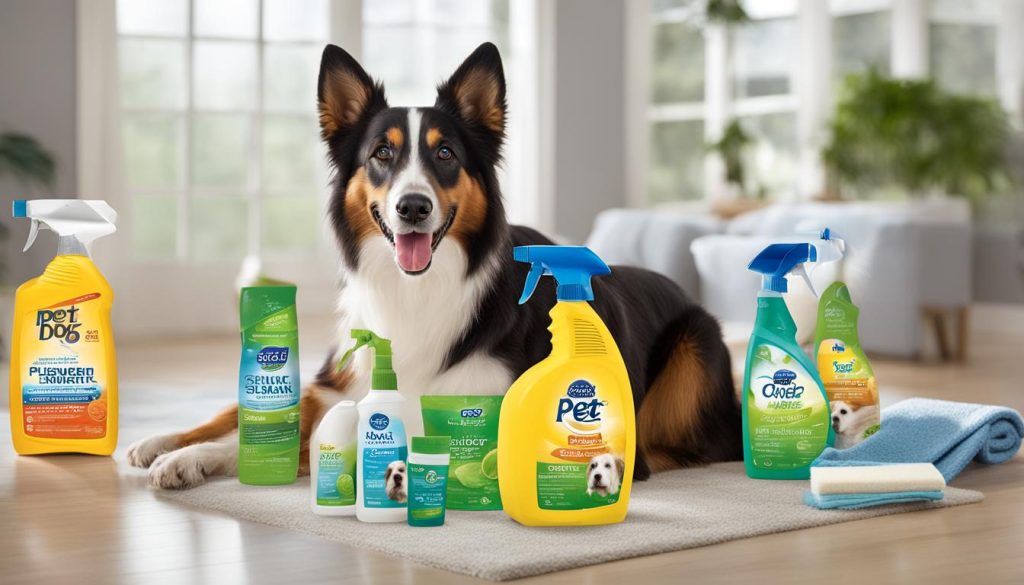Springtime brings warmer weather and outdoor playtime for our pets. However, be aware of potential hazards that can arise during this season. Here are some essential dog springtime safety tips to keep your furry friends protected.
Key Takeaways:
- Regularly check your pet for ticks and remove them promptly to prevent infestation.
- Consult with your veterinarian for proper testing and treatment if your pet is experiencing allergies.
- Be prepared for inclement weather by carrying necessary gear during outdoor activities.
- Choose pet-safe cleaning supplies and keep potentially toxic products out of your pet’s reach.
- Familiarize yourself with common toxic plants and avoid them in your garden or on walks.
Protect Against Fleas and Ticks
Springtime brings warmer weather and outdoor adventures for our furry friends. However, it also brings an increased risk of flea and tick infestations. These parasites can cause discomfort, transmit diseases, and pose health risks for our pets. To keep your dog safe from fleas and ticks, please take preventive measures.
One of the most effective ways to protect your dog is by using veterinarian-recommended flea and tick treatments. These treatments come in various forms, such as spot-on treatments, oral medications, and collars. Consult with your veterinarian to determine the most suitable option for your dog’s needs.
In addition to using preventive products, be mindful of your dog’s environment. Avoid walking your dog in tall grassy areas, as these are common hiding spots for fleas and ticks. Instead, opt for well-maintained paths and keep your dog on a leash to minimize exposure to these parasites. After outdoor activities, thoroughly check your dog’s coat for ticks and promptly remove any you find using tweezers or a tick removal tool.
To ensure your dog’s well-being, I would advise that you stay on top of flea and tick prevention. Regularly monitor your dog for signs of itching, excessive scratching, or skin irritations, as these may indicate a flea or tick infestation. If you notice any unusual symptoms, consult with your veterinarian for further guidance and treatment options.
Allergy Awareness
Just like humans, pets can also suffer from allergies in the spring. It’s important for pet owners to be aware of this and take necessary precautions to keep their furry friends comfortable and healthy. If you notice your pet showing symptoms of allergies, such as itching, redness, swelling, or hair loss, please consult with your veterinarian for proper testing and treatment.
When it comes to allergies, it can be difficult to determine the exact cause without professional help. Your veterinarian can conduct tests to identify specific allergens and recommend appropriate treatment options. They may prescribe antihistamines like Benadryl to help alleviate symptoms, but always consult with your vet before giving any medications to your pet.
In addition to medication, there are other steps you can take to manage your pet’s allergies. Keeping your home clean and free from allergens is essential. Regularly dust, vacuum, and wash your pet’s bedding to minimize exposure to allergens. Additionally, consider using air purifiers to help filter out allergens in your home. Avoiding known allergens, such as certain plants or flowers, can also help reduce your pet’s allergic reactions.
Common Symptoms of Pet Allergies:
- Itching
- Redness
- Swelling
- Hair loss
To put it simply, your veterinarian is your best resource when it comes to managing your pet’s allergies. They can provide personalized advice and recommend the most suitable treatment options for your furry friend’s specific needs. By being proactive and taking necessary precautions, you can help ensure a comfortable and enjoyable springtime for your pet.
Be Prepared for Inclement Weather
Spring weather can be unpredictable, so I would advise that you be prepared. As pet owners, we need to ensure the safety and well-being of our furry friends during outdoor activities. Here are some key tips to help you be prepared for inclement weather and protect your pets:
Outdoor Gear Essentials
Carry necessary gear like rain jackets, umbrellas, and water bottles when heading outdoors with your pet. A sudden downpour or unexpected showers can quickly dampen your outing, but with the right gear, you can keep your pet protected from the rain and ensure they stay dry and comfortable.
Stay Informed about Weather Conditions
Stay updated on the local weather forecast, especially during the springtime when storms can quickly develop. Be aware of any severe weather warnings, including hurricanes or tornadoes, and have a plan in place to safely evacuate with your pets if necessary. Create a go bag with essential items such as food, water, medications, and a leash to make the evacuation process smoother.
Protective Clothing for Pets
Consider investing in protective clothing for your pets, such as doggy booties or lightweight raincoats. These items can provide an extra layer of protection against wet conditions, cold temperatures, and potential irritants like mud or debris. I recommend that you choose clothing that fits properly and doesn’t restrict your pet’s movement.
To put it simply, being prepared for inclement weather is crucial for ensuring the safety and comfort of your pets. By taking the necessary precautions and having the right gear on hand, you can enjoy outdoor activities with your furry friends while keeping them safe from springtime hazards.

Use Pet-Safe Cleaning Products
When it comes to spring cleaning, consider the safety of your pets. Many household cleaning products contain toxic ingredients that can be harmful if ingested or inhaled by your furry friends. To ensure their well-being, please use pet-safe cleaning supplies whenever possible.
Switching to pet-safe cleaning products not only protects your pets but also creates a healthier environment for your entire family. These products are specially formulated to be non-toxic and free of harmful chemicals, making them safe for both humans and pets. Look for cleaning supplies that are labeled as pet-friendly or environmentally friendly.
If it’s necessary to use potentially toxic cleaning products, take extra precautions to keep your pets away from the area being cleaned. Close off the space or use a pet gate to restrict access. Once you’re done cleaning, ensure that all surfaces are thoroughly rinsed and dried to remove any residue.
By using pet-safe cleaning products, you can maintain a clean and fresh home while keeping your pets safe from potential hazards. To put it simply, the well-being of your furry friends is just as important as a clean living environment.

The Advantages of Pet-Safe Cleaning Products
- Non-toxic ingredients that are safe for pets
- Free of harmful chemicals and fumes
- Environmentally friendly
- Prevent accidental poisoning or exposure
- Creates a healthier home for both pets and humans
Using pet-safe cleaning products ensures that your furry friends are protected from harmful chemicals while maintaining a clean and fresh living space.
Beware of Toxic Plants
As spring arrives, many garden enthusiasts are eager to fill their outdoor spaces with beautiful plants and flowers. However, be aware that some of these plants can be toxic to dogs. Keeping your furry friend safe means being knowledgeable about the potential hazards that can arise in your garden or on your walks.
One of the most toxic plants for dogs is the lily. While they may be visually stunning, lilies can cause kidney failure and even lead to death if ingested by cats. I highly suggest that you familiarize yourself with common toxic plants and keep them out of your garden and away from your pet’s reach. If you’re uncertain about a particular plant, consult a veterinarian or refer to a reliable resource on toxic plants.
To help you in identifying some common toxic plants, here’s a table that highlights a few examples:
| Plant | Toxicity Level |
|---|---|
| Lily | Highly toxic to cats |
| Azalea | Highly toxic to dogs and cats |
| Tulip | Moderate toxicity to dogs and cats |
| Daffodil | Moderate toxicity to dogs and cats |
To put it simply, prevention is key when it comes to keeping your dog safe from toxic plants. Ensure that your outdoor space is free from these potential dangers to provide a safe environment for your furry companion.

Keep Chocolate and Easter Treats Away from Pets
Easter brings joy and celebrations, but be cautious when it comes to our furry friends and the treats associated with the holiday. Chocolate, in particular, can be dangerous for pets, especially dogs. Chocolate toxicity can lead to symptoms like vomiting, diarrhea, rapid breathing, increased heart rate, and even seizures or organ failure in severe cases. I highly suggest that you keep chocolate and other Easter treats out of your pet’s reach to prevent any potential harm.

In addition to chocolate, sugar-free candies containing xylitol should also be kept away from pets. Xylitol is toxic to dogs and can cause a sudden drop in blood sugar levels, leading to symptoms like weakness, seizures, and even liver failure. I recommend that you read ingredient labels and ensure that any treats you give to your pets are safe and free from harmful substances.
Creating Pet-Friendly Easter Baskets
Instead of including traditional chocolate and candy-filled Easter baskets for your pets, consider creating pet-friendly alternatives. There are many safe and delicious options available, such as specially made treats for dogs and cats or homemade snacks using pet-safe ingredients. This way, you can still include your pet in the holiday festivities without putting their health at risk.
| Treat Ideas | Description |
|---|---|
| Treat puzzle toys | Engaging toys that dispense treats when played with. |
| Pet-friendly cookies | Bake or buy cookies made specifically for pets, using ingredients that are safe for them. |
| Interactive feeding toys | Toys that require pets to work for their food, providing mental stimulation and a fun challenge. |
| Dental chews | Treats that promote good oral health and help keep teeth clean. |
By opting for pet-friendly Easter baskets, you can ensure that your beloved companions can join in on the holiday celebrations while staying safe and healthy. Try to always prioritize your pet’s well-being and consult with your veterinarian for any specific dietary restrictions or recommendations.
Be Aware of Springtime Hazards
Springtime can bring many joys for pet owners, but be aware of potential hazards that can arise during this season. From toxic plants to seasonal allergies, there are several factors to consider for the safety and well-being of our furry friends.
Allergies and Environmental Dangers
Just like humans, pets can also suffer from allergies in the spring. Dust, pollen, and mold can trigger allergic reactions in dogs, causing symptoms such as itching, sneezing, and watery eyes. If you notice your pet displaying these signs, please consult with a veterinarian for proper testing and treatment. They can provide guidance on managing allergies and recommend appropriate medications or preventive measures.
Additionally, springtime often means an increase in the use of gardening supplies, such as fertilizers, insecticides, and herbicides. These substances can be toxic to pets if ingested or exposed to their skin. You should also store these products securely, out of reach of curious paws, and follow the instructions for their safe usage. If you suspect your pet has come into contact with any potentially harmful substances, contact a pet poison control hotline or your veterinarian immediately.
Outdoor Dangers and Safety Precautions
As the weather warms up, we tend to spend more time outdoors with our pets. However, please be cautious of potential hazards in the environment. For example, certain plants and flowers commonly found in spring gardens can be toxic to dogs and cats. Lilies are particularly dangerous for cats, as they can cause kidney failure. I recommend that you familiarize yourself with toxic plants and avoid them in your garden or on walks. Additionally, if you use weed killers or pesticides, opt for pet-safe alternatives.
Open windows and doors can also pose a risk, especially for cats. Ensure that window and door screens are secure and in good condition to prevent pets from accidentally falling or escaping. Regularly check for any holes or damages in the screens and repair or replace them promptly.
Final Thoughts
Springtime brings its own set of challenges and hazards for our beloved pets. By being aware of potential dangers and taking necessary precautions, we can ensure their safety and well-being during this season. Regular veterinary check-ups, pet-safe cleaning products, and responsible outdoor supervision can all contribute to keeping our furry friends happy and healthy throughout spring and beyond.

Secure Window and Door Screens
As the weather warms up, ensure the safety of your pets by securing window and door screens. This is especially crucial for cats, as they are known to be curious climbers and can easily jump or fall out of windows.
To prevent any accidents, check that your window and door screens are sturdy and properly installed. Inspect them for any holes or damages that could allow your pets to escape or get injured. If you notice any issues, repair or replace the screens as soon as possible.
Additionally, it’s a good idea to supervise your pets when windows or doors are open to prevent them from accessing unsafe areas. Keep in mind that even screens may not be completely foolproof, especially if they are old or damaged. Always prioritize the safety of your pets and take precautions to avoid any potential incidents.
In summary, by securing your window and door screens, you can provide a safe and protected environment for your pets during the spring season.
| Benefits of Securing Window and Door Screens: |
|---|
| Prevents pets from escaping or getting injured |
| Keeps pets safe from falling or jumping out of windows |
| Provides peace of mind for pet owners |
Gradually Increase Activity Levels
As the weather warms up and the days become longer, it’s the perfect time to get outside and enjoy some physical activity with your furry friend. However, after a less active winter, gradually increase your pet’s activity levels to prevent injuries or exhaustion. Here are some tips to help you safely and effectively increase your pet’s exercise routine this spring.
1. Start Slowly: Begin by taking shorter walks or engaging in low-impact activities with your pet. This allows their muscles to gradually build strength and stamina without placing excessive strain on their bodies. As your pet becomes more comfortable and energized, you can slowly increase the duration and intensity of the activities.
2. Mix it Up: Keep your pet’s exercise routine interesting and engaging by incorporating a variety of activities. This can include walks, runs, fetch, swimming, or playing with other friendly dogs. Different activities target different muscle groups and provide mental stimulation, keeping your pet physically and mentally healthy.
3. Listen to Your Pet: Pay attention to your pet’s cues and energy levels during exercise. If they seem fatigued or disinterested, give them a break. Overexertion can lead to injuries, heatstroke, or other health issues. To put it simply, every pet is unique, and some may require more rest than others.
4. Consult with Your Veterinarian: Before making any significant changes to your pet’s exercise routine, it’s always a good idea to consult with your veterinarian. They can assess your pet’s overall health, provide specific recommendations based on their breed, age, and medical history, and help you create a tailored exercise plan.

By gradually increasing your pet’s activity levels and incorporating a variety of exercises, you can ensure that they enjoy a healthy and active spring season. Try to pace yourselves, listen to your pet’s needs, and seek professional advice when necessary. With proper care and attention, you and your furry friend can make the most of the beautiful spring weather together.
Final Thoughts
As a pet owner, please prioritize the safety and well-being of your furry friend, especially during the spring season. By following these dog springtime safety tips, you can ensure a happy and healthy spring for your beloved pet.
Try to provide regular flea and tick prevention to protect your dog from parasites that are more prevalent during this time. It’s also important to be aware of common allergens and consult with your veterinarian if you notice any signs of allergies in your pet.
Prepare for inclement weather and be equipped with the necessary gear to keep your pet safe during outdoor activities. Additionally, be cautious when using cleaning products around your pet and choose pet-safe options whenever possible.
Lastly, be mindful of toxic plants, keep chocolate and Easter treats out of reach, and ensure that window and door screens are secure to prevent accidents. By implementing these safety measures, you can enjoy the beautiful springtime with your furry companion worry-free.
FAQ
How can I protect my dog against fleas and ticks in the spring?
Use preventative flea and tick treatments recommended by your veterinarian. Avoid tall grassy areas on walks and regularly check your pet for ticks.
What should I do if my pet is experiencing allergies in the spring?
Look out for symptoms such as itching, redness, swelling, or hair loss. Consult with your veterinarian for proper testing and treatment.
How should I be prepared for inclement weather in the spring?
Carry necessary gear like rain jackets, umbrellas, and water bottles. Stay updated on the forecast and have a go bag ready to safely evacuate with your pets if needed.
What cleaning products should I avoid using around my pets in the spring?
Many household cleaners contain toxic ingredients. Choose pet-safe cleaning supplies whenever possible and ensure your pet cannot access areas where toxic products are used.
What plants should I avoid in my garden or on walks with my dog in the spring?
Lilies, in particular, are highly toxic to cats. Familiarize yourself with common toxic plants and avoid them. If using weed killers, opt for pet-safe varieties.
How can I keep my pet safe from Easter treats?
Keep chocolate and sugar-free candies containing xylitol out of your pet’s reach. Plastic Easter grass and small objects can also pose choking hazards. Consider creating pet-friendly Easter baskets with safe treats.
What springtime hazards should I be aware of for my pet?
Avoid using toxic gardening supplies. Dust, pollen, and mold can trigger seasonal allergies in pets. Be cautious of rat bait and keep pets away from areas where it is used.
How can I secure window and door screens to prevent my pet from escaping?
Ensure that your window and door screens are sturdy and properly installed. Check for any holes or damages in the screens.
How should I gradually increase my pet’s activity levels in the spring?
Start with shorter walks and gradually increase play sessions and hikes. This allows them to adjust to the increased physical demands and helps prevent injuries or exhaustion.






